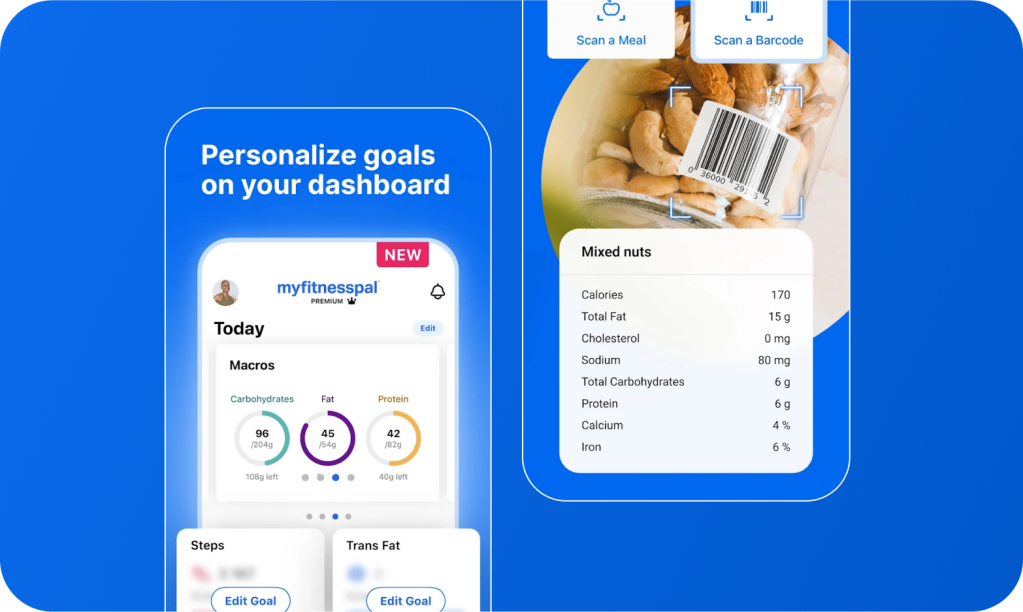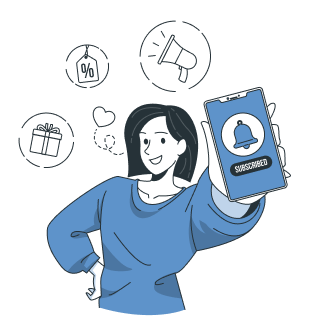Table of Content
MyFitnessPal Journey: A Snapshot
Why Build a Fitness App Like MyFitnessPal
Steps to Build Your Fitness App: A Comprehensive Guide
Features To Build a Fitness App Like MyFitnessPal
Advanced Features of a Fitness App like MyFitnessPal
How Much Does it Cost to Build a Fitness App Like MyFitnessPal?
Go-to-Market Strategy for a Fitness App like MyFitnessPal
Partnering With The Ideal Health & Fitness App Development Company
In a world where health and wellness are at the forefront of lifestyle choices, fitness apps have become the guiding light for millions on their journey to well-being. Among the trailblazers in this digital fitness revolution, MyFitnessPal stands as an iconic success story. Its evolution from a visionary concept to a household name is not only inspiring but also indicative of the immense possibilities within the health tech domain.
In this in-depth guide, we embark on a comprehensive exploration into the realms of building a fitness app like MyFitnessPal. From understanding the intricacies of its success to unraveling the strategic steps, features, and costs involved in app development, this guide serves as your compass in navigating the dynamic landscape of fitness app creation. Without further ado, let’s get started.
MyFitnessPal Journey: A Snapshot
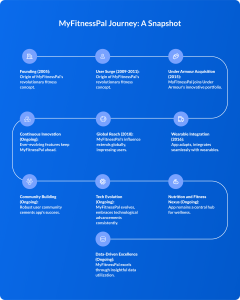
From strategic pivots to global impact, let’s dive into the concise yet impactful milestones that mark MyFitnessPal’s ascendancy in the realm of fitness apps. This journey showcases MyFitnessPal’s evolution from a startup with a vision to a powerhouse in the fitness app industry, influencing millions on their wellness journeys.
Inception (2005):
- MyFitnessPal was born in 2005 when two friends, Mike Lee and Albert Lee, recognized the need for a comprehensive and user-friendly tool to track personal nutrition and fitness. The platform started with a simple idea — empower individuals to take control of their health through accessible and personalized tracking.
Strategic Pivot (2009):
- A pivotal moment in the company’s journey came in 2009 when MyFitnessPal shifted its focus from a website-only platform to a mobile app. This strategic move aligned perfectly with the booming smartphone era, making health tracking more convenient and immediate for users.
Rapid User Growth (2012):
- MyFitnessPal experienced exponential growth in 2012, reaching over 30 million registered users. This surge was fueled by the app’s intuitive design, extensive food database, and social features that fostered a supportive community of health enthusiasts.
Under Armour Acquisition (2015):
- The company’s success caught the attention of athletic apparel giant Under Armour, leading to its acquisition in 2015 for a reported $475 million. This acquisition marked a significant milestone for MyFitnessPal, providing the resources to expand and enhance its features.
Integration and Global Impact (Present):
- Today, MyFitnessPal stands as a global leader in the fitness app domain, with over 200 million registered users worldwide. Its integration with various health and fitness devices, coupled with continuous updates and improvements, solidifies its position as a go-to platform for individuals striving for healthier lifestyles.
Why Build a Fitness App Like MyFitnessPal?
Building a fitness app like MyFitnessPal is not just a business endeavor—it’s a strategic move to tap into a booming market, contribute to a healthier society, and create a transformative impact on individuals’ lives. Let’a take a look at some of the compelling reasons to enter the fitness app space.
-
Market Surge and Health Consciousness:
With a global fitness app market projected to reach $15.96 billion by 2026, there’s a palpable surge in demand. An ever-increasing health-conscious population seeks personalized solutions, creating an opportune market for a new entrant to make a substantial impact.
-
Trend Integration for User Appeal:
MyFitnessPal’s success story is intricately tied to its early embrace of trends like mobile health tracking and personalized fitness plans. In a tech-driven age where 86.3 million people in the US have used at least one health or fitness app a month, aligning with these trends can indisputably maximize your app’s appeal.
-
Monetization Potential and Revenue Streams:
The financial landscape is equally promising, with the fitness app industry offering diverse monetization channels. Premium subscriptions, accounting for 49% of global fitness app revenue, in-app purchases, and partnerships are lucrative avenues, making it a venture with substantial revenue potential.
-
Impactful Contribution to Healthy Lifestyles:
Beyond financial gains, your app can contribute to a healthier society. As obesity rates climb globally, a fitness app becomes a tool for users to monitor nutrition, exercise, and adopt healthier lifestyles. It’s not just an app; it’s a societal contribution.
-
Community-Centric Engagement:
Community building is the heartbeat of successful fitness apps. MyFitnessPal’s robust community, with over 200 million registered users globally, illustrates the potential for engagement. A strong community not only fosters loyalty but also amplifies the app’s impact.
-
Tailoring for Individual Preferences:
The ability to customize and personalize fitness plans is a key differentiator. In a world where individualization matters, offering tailored features can be a significant draw, contributing to user satisfaction and app retention.
Steps to Build Your Fitness App: A Comprehensive Guide
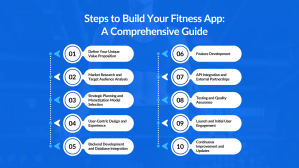
Step 1: Define Your Unique Value Proposition
Creating a fitness app begins with defining what makes it stand out. First, figure out what makes your app special – maybe it’s an exciting feature, a friendly design, or a new way to track health. These special things lay the groundwork for your app to succeed.
After finding these unique elements, consider how well they match what your users want. Perhaps your target users are looking for a fitness app that makes their health journey enjoyable and personalized. Standing out isn’t just about being different; it’s about creating a workout experience that keeps users coming back.
Step 2: Market Research and Target Audience Analysis
To create an app people love, it’s crucial to understand who your users are and what they need. Conduct thorough research to uncover the preferences, challenges, and expectations of your fitness-focused audience. Are your target users fitness enthusiasts seeking personalized workout plans and nutritional guidance? This sort of insight becomes your guiding compass, directing the development of features that directly cater to their needs, such as real-time workout tracking, meal suggestions, and progress analytics.
In tandem, explore the existing fitness app landscape. Analyze the strengths and weaknesses of these apps, identifying opportunities for improvement and innovation. For instance, if you notice a gap in comprehensive nutrition tracking among existing fitness apps, you might incorporate a feature that precisely addresses this need. This dual approach not only shapes the design of your app but also strategically positions it within the competitive fitness app market, ensuring it stands out as a tailored solution for health-conscious users.
Step 3: Strategic Planning and Monetization Model Selection:
Planning is the roadmap for your fitness app journey. Set clear goals and milestones to guide your development process. A basic goal can be to help users track their daily nutrition intake and exercise routines. Setting milestones involves specifying key features like personalized meal planning and workout logs, ensuring each step aligns with the ultimate vision of creating a comprehensive health companion.
Now, as you strategize, consider how your app will generate revenue. In the realm of fitness apps, subscription-based models have proven to be the champions, aligning seamlessly with user expectations for continuous support and premium features. This model mirrors the success of apps like MyFitnessPal, where users willingly invest in a subscription for enhanced functionalities, unlocking a premium fitness experience.
Step 4: User-Centric Design and Experience
User experience is the heart of any successful app. Design your fitness app with simplicity and user-friendliness in mind. Ensure that navigation is intuitive, features are easily accessible, and the overall interface is inviting.
Think about the user journey – from opening the app for the first time to achieving their fitness goals. A straightforward and enjoyable experience not only attracts users but keeps them engaged, fostering a sense of connection with your app.
Step 5: Backend Development and Database Integration
While users interact with the visible features, the backend is the engine that powers your fitness app. Build a robust foundation capable of handling data securely and efficiently. Think of it as the infrastructure that ensures your app operates smoothly and can scale as your user base grows.
Prioritize aspects like data security, server reliability, and database management. A strong backend sets the stage for a dependable and responsive app, enhancing the overall user experience.
Step 6: Feature Development
Now comes the exciting part – adding features that make your app truly special. Consider features such as nutrition tracking, exercise logging, goal setting, and social connectivity. Each feature should contribute to the overall narrative of your app, creating a comprehensive and engaging user experience.
Think about how these features seamlessly integrate into the user’s fitness journey. Whether it’s providing insightful data, offering personalized recommendations, or fostering a sense of community, each feature should enhance the user’s interaction with your app.
Step 7: API Integration and External Partnerships
Expand the horizons of your fitness app by connecting with other health and wellness platforms. Integrate APIs that allow seamless communication with databases and consider partnerships with external brands. This interconnected approach creates a holistic health ecosystem, providing users with a comprehensive tool to enhance their well-being.
Think of it as joining a community of health enthusiasts where your app becomes a central hub. This collaborative effort enriches the user experience and positions your app as part of a larger health and fitness network.
Step 8: Testing and Quality Assurance:
Before unveiling your creation to the world, conduct rigorous testing. Identify and address any bugs, glitches, or usability issues to ensure a smooth and error-free experience for users. Testing isn’t just about finding problems; it’s about fine-tuning your app to deliver a reliable and enjoyable experience.
Think of this phase as a meticulous checkup, ensuring that every aspect of your app aligns with the high standards you’ve set. Iterative testing and refinement lead to a polished and dependable product that instills confidence in your users.
Step 9: Launch and Initial User Engagement:
Launching your fitness app is the grand reveal of your hard work. Create a strategic launch plan that generates excitement and anticipation. Utilize marketing strategies to introduce your app to the world, inviting users to be part of a new and transformative health experience. Make it memorable, showcase the unique features, and communicate the value your app brings to users’ lives.
Step 10: Continuous Improvement and Updates:
The journey doesn’t end with the launch; it’s an ongoing evolution. Listen to user feedback, analyze app performance, and stay attuned to market trends. Regular updates ensure your app remains fresh, innovative, and aligned with the evolving needs of your user base.
Each update introduces new elements, refines existing features, and keeps users excited about what’s next. This commitment to continuous improvement positions your app as a dynamic and ever-relevant player in the health and fitness landscape.
Also Read: Develop a Healthcare App
Features To Build a Fitness App Like MyFitnessPal
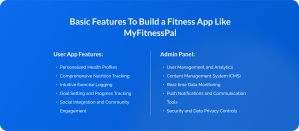
Now that we’ve understood the process to build a fitness app like MyFitnessPal, let’s take a closer look at some of the integral components that elevate a fitness app, transforming it into a personalized wellness companion. From intuitive exercise logging to comprehensive nutrition tracking, each feature serves a distinct purpose in enhancing user engagement, motivation, and overall fitness success. Understanding these essential features lays the groundwork for a transformative fitness experience. Here are some of the handpicked features to build a fitness app like MyFitnessPal:
Basic User App Features
-
Personalized Health Profiles
The Personalized Health Profiles feature serves as the foundation for a user’s experience within the fitness app. Users kick off by providing essential details like height, weight, and their fitness objectives. This straightforward data entry process sets the stage for a personalized dashboard tailored to the individual.
The feature transforms abstract fitness aspirations into manageable, achievable goals. Users gain a tangible snapshot of their progress, creating a sense of accomplishment and motivation. The Personalized Health Profiles feature isn’t just a data repository; it’s a living record of one’s fitness evolution.
-
Comprehensive Nutrition Tracking
The Comprehensive Nutrition Tracking feature acts as a nutritional compass within the fitness app. Users engage by logging their daily food intake, utilizing a vast food database for effortless tracking of caloric, macronutrient, and micronutrient consumption.
Beyond being a mere food log, Comprehensive Nutrition Tracking transforms nutritional aspirations into tangible achievements. Users gain a clear understanding of their dietary patterns, making it easier to adopt a balanced lifestyle. This feature is a practical ally, contributing to the overall well-being of users by simplifying the complexities of nutrition and promoting healthier eating habits.
-
Intuitive Exercise Logging:
The Intuitive Exercise Logging feature is the user’s workout companion, simplifying the fitness journey within the app. It provides a seamless platform to log various exercises, complemented by an extensive exercise database.
Beyond being a simple log, Intuitive Exercise Logging transforms fitness aspirations into achievable milestones. Users receive personalized insights into their workout patterns, helping them stay motivated and focused on their fitness goals. This feature is a practical motivator, making the fitness journey more accessible and enjoyable for users of all levels.
-
Goal Setting and Progress Tracking:
The Goal Setting and Progress Tracking feature emerge as pivotal motivators within the fitness app. Users set health objectives and track their progress through tools like charts and milestone notifications. It’s not just about staying focused; this feature fosters a sense of accomplishment and encouragement at every stage of the fitness journey.
Users receive constant motivation, celebrating their victories and staying committed to their health objectives. This feature is more than a virtual pat on the back; it’s a catalyst for sustained fitness success, making the journey more rewarding and encouraging.
-
Social Integration and Community Engagement:
The Social Integration and Community Engagement feature bring users into the vibrant heart of the fitness community within the app. It provides a space to share achievements, connect with like-minded individuals, and participate in challenges. This feature isn’t just about an app; it’s about fostering a supportive environment where everyone cheers each other on, enhancing the overall fitness experience.
This feature is a catalyst for building a fitness community, making the journey more than an individual effort but a collective celebration of health and well-being.
Admin Panel
-
User Management and Analytics:
User Management and Analytics provide a comprehensive overview of user interactions within the fitness app. Admins can efficiently manage user profiles, ensuring a seamless and secure experience. Analytics delve into user behavior, offering valuable insights that inform strategic decisions for app enhancement. All in all, User Management and Analytics are not just administrative tools; they are key contributors to the app’s evolution and success.
-
Content Management System (CMS):
The Content Management System (CMS) in the control hub for all app content. Admins can seamlessly update, organize, and curate information, ensuring that users receive timely and relevant content. This feature streamlines content delivery, maintaining the app’s freshness and relevance.
CMS goes beyond routine content updates; it’s the engine driving user engagement. Admins have the power to keep the app dynamic, responding to trends, user needs, and industry updates promptly. This feature is the backbone of a responsive and user-centric fitness app, delivering valuable content that keeps users informed and motivated.
-
Real-time Data Monitoring:
Real-time Data Monitoring emerges as a crucial feature, offering admins an instantaneous view of the app’s performance. It transforms the admin’s role from reactive to proactive. Admins can promptly address emerging concerns, optimize app performance based on live insights, and deliver an uninterrupted user experience. This feature is the guardian of app stability and responsiveness.
-
Push Notifications and Communication Tools:
Push Notifications and Communication Tools in the Admin Panel empower admins to engage users effectively. Admins can send targeted notifications, updates, and announcements, fostering direct communication with the user base. This feature ensures that users stay informed, motivated, and connected with the app’s offerings.
Admins can inspire, inform, and guide users through their fitness journey, creating a sense of community and personal connection. This feature is the bridge that keeps users actively involved and invested in their health goals.
-
Security and Data Privacy Controls:
The Security and Data Privacy Controls form the fortification against potential threats, ensuring the confidentiality and integrity of user data. Admins have the tools to implement robust security measures, adhering to industry standards and regulations.
Security and Data Privacy Controls instill confidence in users, assuring them that their personal information is handled with the utmost care. Admins contribute to creating a secure environment, reinforcing the app’s credibility and user trust. This feature is not just a compliance necessity; it’s a commitment to user data protection and ethical app management.
Advanced Features of a Fitness App like MyFitnessPal

Biometric Integration:
Biometric Integration seamlessly integrates with devices capable of tracking biometric data, such as heart rate monitors and smartwatches. Beyond standard fitness metrics, Biometric Integration transforms the app into a comprehensive health companion, providing users with a nuanced understanding of their well-being.
AI-Powered Personalization:
AI-Powered Personalization revolutionizes the fitness journey by leveraging artificial intelligence to tailor recommendations and plans based on individual preferences, performance, and goals. This advanced feature adapts and evolves, offering users a dynamic and ever-improving fitness experience.
Augmented Reality (AR) Workouts:
Augmented Reality (AR) Workouts bring a new dimension to fitness by overlaying digital elements onto the real world. Users can engage in immersive workouts, following virtual trainers or participating in interactive challenges within their own environment.
Beyond traditional workouts, AR transforms the fitness app into a dynamic playground, fostering a more enjoyable and visually stimulating fitness routine.
Integration with Smart Equipment:
This advanced feature elevates the fitness experience by seamlessly connecting with smart gym equipment. Users can synchronize their app with devices like smart treadmills or strength training machines, enhancing workout tracking and providing a more unified fitness approach.
Apart from standalone tracking, Integration with Smart Equipment streamlines the workout process, ensuring accurate data collection and a cohesive fitness routine.
Virtual Health Coaching:
Virtual Health Coaching introduces a personalized and interactive element to the fitness app, where users receive guidance and support from virtual health coaches. This advanced feature goes beyond automated suggestions, offering real-time advice, motivation, and feedback.
Virtual Health Coaching adds a human touch to the fitness journey, fostering a sense of accountability, encouragement, and personalized guidance.
How Much Does it Cost to Build a Fitness App Like MyFitnessPal?
Building a fitness app like MyFitnessPal involves various factors that contribute to the overall cost. On average, the development cost for a feature-rich fitness app falls within the range of $100,000 to $300,000. This estimation covers expenses related to app design, development, backend infrastructure, integration of essential features, and testing.
The complexity of features, platform compatibility (iOS and Android), user interface intricacies, and additional advanced functionalities contribute to the variance in cost. Collaborating with a skilled development team, considering ongoing maintenance and updates, and allocating resources for marketing efforts are essential aspects to factor into the budget.
Recommended Read: How Much Does Healthcare App Development Cost in 2024?
Go-to-Market Strategy for a Fitness App like MyFitnessPal
Launching a fitness app requires a robust Go-to-Market (GTM) strategy to effectively position the product in the competitive landscape. Leveraging digital marketing for healthcare is a pivotal element in this strategy, aligning with the current trends and user preferences. MyFitnessPal, for instance, has adeptly utilized healthcare digital marketing services to reach a broader audience.
To kickstart your GTM approach, consider a multi-channel digital marketing strategy that encompasses social media platforms, search engine optimization (SEO), and influencer partnerships.
Social Media Platforms:
Social media platforms provide an avenue for engaging content, user testimonials, and community-building, fostering a sense of connection among fitness enthusiasts. MyFitnessPal has successfully utilized these channels, harnessing the power of user-generated content to create a dynamic and supportive community.
Search Engine Optimization:
In addition, optimizing your app’s online presence through SEO practices ensures higher visibility on search engines, increasing the likelihood of organic user acquisition. MyFitnessPal’s strategic use of keywords related to health, fitness, and nutrition has undoubtedly contributed to its prominent position in search engine results.
Influencer Marketing:
Collaborating with influencers in the fitness and wellness space can amplify your app’s reach. Influencers often have a dedicated following, making them influential in promoting health and fitness apps. This approach aligns with B2B healthcare marketing strategies, forming partnerships that extend your app’s visibility within the healthcare ecosystem.
Referral Programs & Partnerships:
Consider implementing referral programs and partnerships with healthcare professionals, gyms, or nutritionists to expand your user base. MyFitnessPal’s success has been partly attributed to its user-friendly interface and its integration with various health and fitness professionals, establishing credibility and trust among users.
Ultimately, a comprehensive Go-to-Market strategy integrates digital marketing for healthcare with a user-centric approach, creating a seamless and engaging experience for your target audience.
Partnering With The Ideal Health & Fitness App Development Company
Partnering with a reliable and trusted app development company is a crucial step in bringing your health and fitness app vision to life. The right development partner not only possesses technical expertise but also understands the intricacies of the health and wellness industry. Such a collaboration ensures that your app not only meets industry standards but also addresses the unique needs and preferences of your target audience.
With a proven track record in health and fitness app development, InfoStride emerges as the ideal fit for building a diverse range of healthcare solutions, including a MyFitnessPal-like app. We combine our technical excellence with a deep understanding of the healthcare domain. Our team of skilled developers, designers, and industry experts collaborates seamlessly to create user-friendly, feature-rich apps tailored to specific client needs. By choosing InfoStride as your development partner, you gain access to a wealth of experience, innovation, and a commitment to delivering high-quality solutions in the dynamic landscape of health and fitness technology.
Our Top Picks
eCommerce Website Development Cost
How to Create an Online Marketplace
